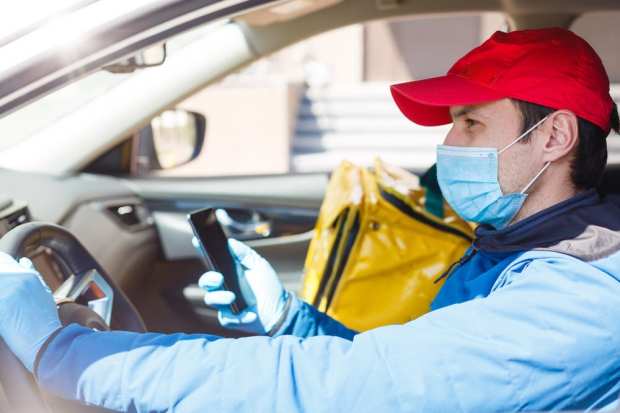Merchants Break Out Omnichannel Innovations To Maintain Sales Through 2021

SMBs that have survived the impacts of the pandemic are now confronting new hurdles: winter and a potential second COVID-19 wave. In the 2021 New Merchant Business Models Playbook, Katie Swett Miller, eCommerce product lead at Square, runs down which payments and tech innovations restaurants and retailers must take into the new year — and what they should leave in the rearview mirror.
The COVID-19 pandemic shocked many small U.S. businesses when it hit in the early spring and sent them scrambling to continue reaching customers and generating revenues. These merchants have spent months considering their approaches and testing new ideas, and they are now better prepared to make the operational adjustments necessary to reduce the spread of the virus and to address weather-related challenges.
PYMNTS recently spoke with Katie Swett Miller, eCommerce product lead at payment platform provider Square, to discuss how SMBs are continuing to make sales during the pandemic and preparing themselves for whatever the future has in store.
“In March, we saw a lot of sellers throwing a few things at the wall to figure out, ‘what’s going to stick, what are my buyers interested in and how can I adapt really quickly through this period?’” Miller said. “Now we’re in a period where those sellers have figured out some of the pieces that have really worked for their businesses, and [they] are trying to figure out, ‘how do I how operationalize this and grow it even more going into 2021?’”
SMBs have tried various approaches, and the necessity of omnichannel is emerging. Providing numerous purchasing options through websites, mobile channels and social media is becoming essential for businesses that wish to create seamless, convenient experiences that resonate with consumers who have different comfort levels regarding on-site shopping, Miller explained.
Ordering Goes Hyperlocal
Consumers who had exclusively placed digital orders with non-local retailers are now using these services for merchants that are closer to home. Remote channels are enabling them to more safely transact with local venues. This trend has pushed retailers to improve their online offerings by adding conveniences such as same-day delivery and quick inventory updates, Miller explained. SMBs are realizing that they cannot afford lags between when items are depleted in-store and when they are listed as out of stock online.
“[If the] customer comes to [the] store to pick up something and it’s sold out, that’s pretty defeating, especially as buyers are trying to take fewer trips and be out less and consolidate the amount of in-person shopping they’re doing,” she said.
Merchants are also leveraging remote ordering capabilities to deliver products to shoppers who are at their venues. Miller said that one Australian concert hall offers merchandise deliveries to customers seated at socially distant tables to prevent attendees from huddling together in lines at merchant stands, for example. Some retailers are also exploring ways to marry window shopping with digital ordering. Small stores are looking to serve a high volume of customers during the holiday season, even if their physical footprints are not large enough to safely allow many shoppers inside.
“Sellers that have smaller physical presences are nervous about how many people they can accommodate in that store, but they still have the traffic of people walking past,” Miller explained. “A lot are planning to put up QR codes that link to a digitized lookbook or online store, so buyers can browse a curated set of items and, from that experience, could actually order [them] for pickup.”
Retailers are actively considering these kinds of innovations, which could reduce or eliminate the need for shoppers to examine items in stores and instead encourage them to make their purchasing decisions outside. Customers could then either enter the store to buy the items or have them delivered to the shop’s front door. Such efforts can prevent bottlenecks and crowding.
Restaurants Reclaim, Redesign Ordering
Restaurants are generally more familiar with delivery and digital ordering options than retailers, but even these players are rethinking their strategies as they cope with long months of financial strain and search for new ways to leverage technologies that support sales. Miller has observed more restaurants pivot away from using third-party ordering aggregators and toward taking control of the process themselves. This spares them from the sizable fees most services charge, which can cut painfully into the industry’s already-slim margins.
“Restaurants are starting to own some of that [pickup and delivery] experience themselves because that volume has picked up so drastically and they need to make more money as in-person experiences are decreasing,” Miller explained.
Restaurants that may have been better able to endure third-party aggregators’ fees when their in-store revenues were more robust are now rethinking such services during the pandemic, she said. On-site dining has not vanished entirely, and eateries are innovating to try to maintain this service. Some venues swapped paper menus for digital ones during the earlier months of the pandemic to reduce diners’ contact with shared public items, and restaurants are continuing to digitize their on-site experiences. Some are debuting QR codes that customers can scan to view menus, order and pay without touching paper or coming in close proximity to servers. This also reduces the number of table visits servers must make and how frequently they must walk through restaurants.
Even solutions like these are not enough to bring back all of the customers who previously sought out table service, however. The Centers for Disease Control and Prevention (CDC) has labeled venues that offer on-site dining — even if they have reduced capacity, spaced-out tables and a mix of indoor and outdoor seating — as higher-risk than those exclusively offer takeout and delivery, and this risk can dampen diners’ interest and prompt local governments to restrict services.
Most full-service and fine-dining establishments have struggled to translate their appeal into to-go formats, but Miller said many are turning to promising new solutions. Some are now selling meal kits that customers prepare during livestreamed cooking classes, for example. Other offerings include Zoom-based wine-tasting parties and picnic boxes, which are intended to create social experiences that tie into restaurants’ areas of expertise, helping them remotely capture some of the more atmospheric factors that typically drive patronage.
The pandemic has deeply strained restaurants’ and retailers’ operations, and no single solution can guide all merchants through the issues they face. Businesses are innovating and tapping into various omnichannel tools to help them reach customers in-store and remotely. That can mean letting shoppers collect items from stores when they wish to quickly pick up purchases and ensuring that they will not have to spend significant amounts of time in crowded public spaces. The impending colder weather is poised to bring new challenges, but merchants are preparing with insights gleaned from months spent reacting to the pandemic and testing new ideas that could help them survive and even thrive.

